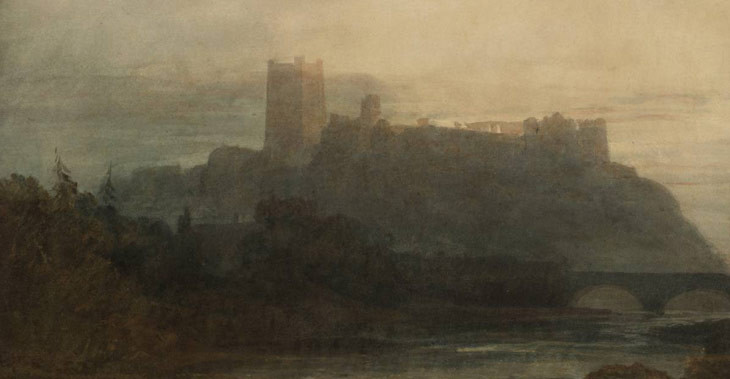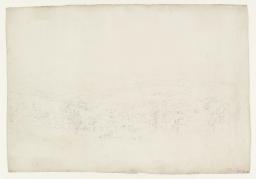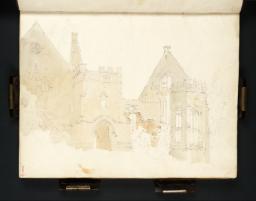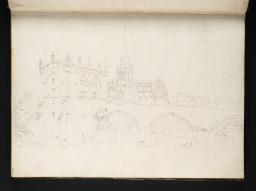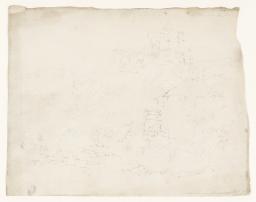The 1797 North of England Tour, Related Works and Other Subjects 1797–1801
From the entry
Turner had already travelled as far north as the Dee estuary and Derbyshire on his tour of the Midland counties in 1794. In 1797 his extraordinarily well-planned career took him logically to Yorkshire, Lancashire and the counties adjoining the Scottish border. Once again, though, the logic seems to have been determined by chance. He received commissions from Edward Lascelles, of Harewood in Yorkshire, to make views of the house that had been built in the 1750s to designs by John Carr of York, a kinsman by marriage of the Lascelles family, with considerable contributions, notably some fine interiors, by Robert Adam. But perhaps chance too was under Turner’s firm control: by this date he was in demand as a topographical watercolourist and perhaps had the luxury of enough commissions to be able to plan his journeys with remuneration in mind, while at the same time extending his knowledge of the country and collecting new subjects for his brush. A similar pattern can be discerned behind his Welsh tours of the following two ...
North of England Sketchbook 1797
D00906–D00987, D00989–D01002, D40560–D40567, D41412
Turner Bequest XXXIV 1–91
D00906–D00987, D00989–D01002, D40560–D40567, D41412
Turner Bequest XXXIV 1–91
D00682, D00873, D00890, D00891, D01095–D01099, D01101–D01103, D01106–D01108, D01111–D01114, D01116, D01117, D01879, D02343, D02344, D02358, D02360, D02361, D02365–D02373, D02379, D02385–D02392, D04169, D08263, D08264, D17202, D40061, D40190, D40253, D40264
Turner Bequest XXVII U, XXXIII B, S, T, XXXVI A, B, C, D, E, G, H, I, L, M, N, Q, R, S, T, V, W, XLIV C, L B, C, Q, S, T, X, Y, Z, LI A, B, C, D, E, F, L, R, S, T, U, V, W, X, Y, LXX R, CXXI H, I, CXCVII L
Turner Bequest XXVII U, XXXIII B, S, T, XXXVI A, B, C, D, E, G, H, I, L, M, N, Q, R, S, T, V, W, XLIV C, L B, C, Q, S, T, X, Y, Z, LI A, B, C, D, E, F, L, R, S, T, U, V, W, X, Y, LXX R, CXXI H, I, CXCVII L
Turner had already travelled as far north as the Dee estuary and Derbyshire on his tour of the Midland counties in 1794. In 1797 his extraordinarily well-planned career took him logically to Yorkshire, Lancashire and the counties adjoining the Scottish border. Once again, though, the logic seems to have been determined by chance. He received commissions from Edward Lascelles, of Harewood in Yorkshire, to make views of the house that had been built in the 1750s to designs by John Carr of York, a kinsman by marriage of the Lascelles family, with considerable contributions, notably some fine interiors, by Robert Adam.1 But perhaps chance too was under Turner’s firm control: by this date he was in demand as a topographical watercolourist and perhaps had the luxury of enough commissions to be able to plan his journeys with remuneration in mind, while at the same time extending his knowledge of the country and collecting new subjects for his brush. A similar pattern can be discerned behind his Welsh tours of the following two years.
There is also a perceptible development of his approach to recording subjects. The two books he took with him to the north in 1797, North of England and Tweed and Lakes, were larger than any previous sketchbooks he had used, substantially bound in calf and of good Whatman paper. They mark a departure from the small, intimate books he had been using in London and on the south coast: Wilson and Studies near Brighton (Tate; Turner Bequest XXXVII, XXX). The greatly increased page size, which he must have determined on after having made his virtuoso study of the Octagon at Ely on his 1794 tour (Tate D00369, Turner Bequest XXII P), permitted him to analyse in searching detail the intricacies of Gothic architecture at Doncaster, Pontefract, Ripon and elsewhere, while allowing scope for broad landscape views in the Lake District. Some of these studies were enhanced with watercolour. These refinements of his methods of gathering material were paralleled by an increasingly ambitious approach to the finished work, whether watercolour views for patrons or paintings, in either oil or watercolour, for display in the Royal Academy’s exhibitions.
He underlined the significance of his exhibited work by taking advantage of a new Academy ruling, first implemented in 1798, that catalogue entries might be accompanied by quotations from the poets. Turner acquired a comprehensive collection of poetry, the thirteen volumes of Robert Anderson’s Works of the British Poets, with Prefaces Biographical and Critical, published in 1795.2 This, despite its title, included translations of ancient Greek and Latin poetry, of which Turner availed himself at various moments in his career. At first he took his citations chiefly from John Milton (1608–1674) and James Thomson (1700–1748), but it is clear that he read widely in these volumes and that sometimes he was inspired to paint a particular subject by the poetry itself. Very soon he was composing his own verses to accompany his pictures, and in due course a long, amorphous poem that he called the Fallacies of Hope appeared from time to time among his catalogue entries.3 It remained among his literary references until the very end of his life.
See David Hill, ‘Lascelles, Edward, senior (1740–1820) and junior (1764–1814)’ in Evelyn Joll, Martin Butlin and Luke Herrmann (eds.), The Oxford Companion to J.M.W. Turner, Oxford 2001, pp.161–2.
How to cite
Andrew Wilton, ‘The 1797 North of England Tour, Related Works and Other Subjects 1797–1801’, November 2013, in David Blayney Brown (ed.), J.M.W. Turner: Sketchbooks, Drawings and Watercolours, Tate Research Publication, November 2014, https://www

